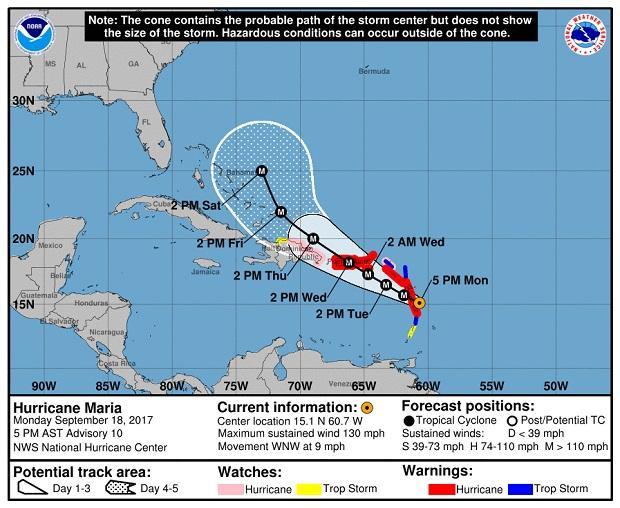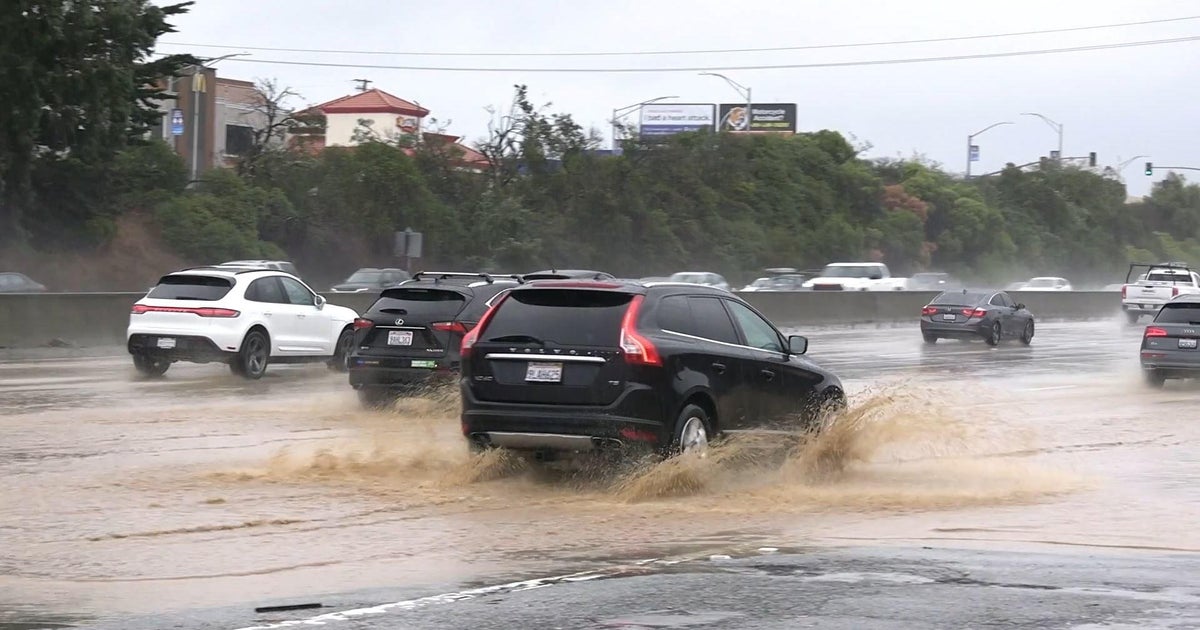Hurricane Maria Strengthens To Category 5; New Warnings Issued In Caribbean
SAN JUAN, Puerto Rico (CBS News) -- Hurricane Maria is now a Category 5 storm, the U.S. National Hurricane Center (NHC) said Monday evening.
Air Force Reserve aircraft data indicates that Maria has intensified into an "extremely dangerous" storm with maximum winds of 160 mph with higher gusts, the center said.
The storm was on a path that would take it near many of the islands already wrecked by Hurricane Irma and then on toward Puerto Rico and the Dominican Republic. Maria could hit Puerto Rico on Wednesday, said Ernesto Morales with the U.S. National Weather Service in San Juan.
"This storm promises to be catastrophic for our island," he said. "All of Puerto Rico will experience hurricane force winds."
Hurricane warnings were issued for Puerto Rico, Culebra, Vieques, the U.S. and British Virgin Islands, Guadeloupe, Dominica, St. Kitts, Nevis, Montserrat and Martinique. A tropical storm warning was issued for Antigua and Barbuda, Saba, St. Eustatius, St. Maarten, St. Lucia and Anguilla.

Hurricane Maria's projected path as forecasted on Mon., Sept. 18, 2017, by the U.S. National Hurricane Center.
NHC says the center of Maria will move near Dominica and the adjacent Leeward Islands during the next few hours, over the extreme northeastern Caribbean Sea the remainder of tonight and Tuesday and approach Puerto Rico and the Virgin Islands Tuesday night and Wednesday.
Hurricane-force winds extend outward up to 25 miles from the center, NHC says, and tropical-storm-force winds extend outward up to 125 miles.
University of Miami hurricane researcher Brian McNoldy says one key sign of Maria's growing strength is what center forecasters call "the dreaded pinhole eye." Maria's eye has shrunk to 10 miles in diameter -- a smaller, tighter eye makes the hurricane spin faster.
McNoldy says meteorologists saw a similar pinhole eye when Hurricane Wilma set a record for lowest central pressure -- a key measure of storm power -- in 2005.
President Trump approved an emergency declaration for the U.S. Virgin Islands ahead of Maria, ordering federal assistance to aid the response effort, the White House said in a statement Monday.
The action authorizes the Federal Emergency Management Agency (FEMA) to coordinate disaster relief efforts.
"FEMA is authorized to identify, mobilize, and provide, at its discretion, equipment and resources necessary to alleviate the impacts of the emergency," the statement said.
In the French Caribbean territory of Martinique, French authorities have ordered residents to stay home as Maria approaches the island. Authorities said in a statement that all rescue and security services on the island are on standby, including 600 firefighters, 400 police officers and 500 troops.
All schools and public services are closed. Residents should shelter in the safest room of their homes and be prepared for power cuts and a disruption in the water supply.
In Dominica, officials closed schools and government offices on Monday and urged people to evacuate and seek shelters.
"We should not take this storm lightly," said Prime Minister Roosevelt Skerrit. "Let us continue to pray for our safety."
Officials in Guadeloupe said the French Caribbean island would experience extremely heavy flooding starting Monday afternoon, and they warned that many communities would be submerged overnight.
On Wednesday, Maria was expected to be near or over Puerto Rico, which was spared the full brunt of Irma, although much of the island had its power knocked out. Nearly 70,000 people remain without power, and Gov. Ricardo Rossello on Monday warned of another widespread outage.
"We have an extremely weak infrastructure that has already been hit by one storm," he said. "This is going to be a catastrophic event."
Forecasters said the storm would dump up to 18 inches of rain across Puerto Rico and whip the U.S. territory with heavy winds for 12 to 24 hours.
Officials said the Federal Emergency Management Agency was ready to bring drinking water and help restore power in Puerto Rico immediately after the storm. Rossello said officials had prepared about 450 shelters with a capacity for nearly 68,000 people -- or even 125,000 in an emergency. Schools were cancelled for Monday and government employees would work only a half day.
Officials in Puerto Rico imposed a rationing of basic supplies including water and baby formula Monday, saying it is necessary to ensure everyone has access to basic items such as batteries, milk, canned foods, flashlights and other things. It does not apply to gasoline or other fuels.
Shelves at many stores were emptying out quickly as people rushed to finalize hurricane preparations. Many posted desperate pleas on social media for help in finding certain items.
Officials said some stores already were imposing their own rationing measures and stressed that more merchandise was scheduled to arrive on Monday to replenish shelves.
In the Dominican Republic, authorities urged people to leave areas prone to flooding and said fishermen should remain in port.

This satellite image from the National Oceanic and Atmospheric Administration (NOAA) shows Hurricane Maria on Mon., Sept. 18, 2017.
Further north, long-lived Hurricane Jose continued to head northward off the U.S. East Coast, causing dangerous surf and rip currents. It wasn't expected to make landfall but tropical storm watches were posted along the coast from Delaware to Massachusetts' Cape Cod.
Jose was centered about 265 miles east-southeast of Cape Hatteras, North Carolina, and was moving north at 9 mph. It had maximum sustained winds of 75 mph.
Jose is expected to bring rough seas and dangerous rip currents to New Jersey and Long Island's shorelines early this week, CBS New York reported.
National Guard officials said Monday that the departure of 100 soldiers in a Buffalo-based military police unit and 30 troopers has been delayed because of Maria as it pushes toward the eastern Caribbean.
The New York contingent was set to depart from Niagara Falls Air Reserve Station aboard a military aircraft for St. Thomas, one of several Caribbean islands devastated by Hurricane Irma.
© 2017 CBS Interactive Inc. All Rights Reserved. This material may not be published, broadcast, rewritten, or redistributed. The Associated Press contributed to this report.



